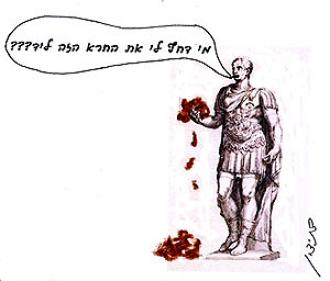
The sages forbade the use of or benefit from icons and statues of Babylonian, Greek, or Roman kings (such as statues of Augustus or Julius Caesar) because people treated these kings as gods and worshiped them. One of the sages introduced limits to this rule and stated that if the statue represents a person holding something in his hands (a stone, a toothpick, etc.) it is forbidden, but if the statue represents a person not holding something in his hands, it is permitted to use and gain benefit from the statue. One of the sages asked what the rule would be if the statue represented a person holding excrement in his hand. Would that be permitted or not? What are the issues under debate? This statue (of a caesar holding excrement in his hand) can be understood in one of two ways. On one hand, this is degrading to the caesar, for he is represented as holding excrement, so one could not bow and worship this degrading figure; use of this statue should be permitted. On the other hand, the statue holding excrement could be interpreted to mean that the royal figure sees the world as excrement, thus demonstrating his power and authority. According to this interpretation of the statue, the statue would be forbidden for use or benefit. (This debate was not resolved in the Talmud.)
(Babylonian Talmud Tractate Avodah Zarah 41a)
